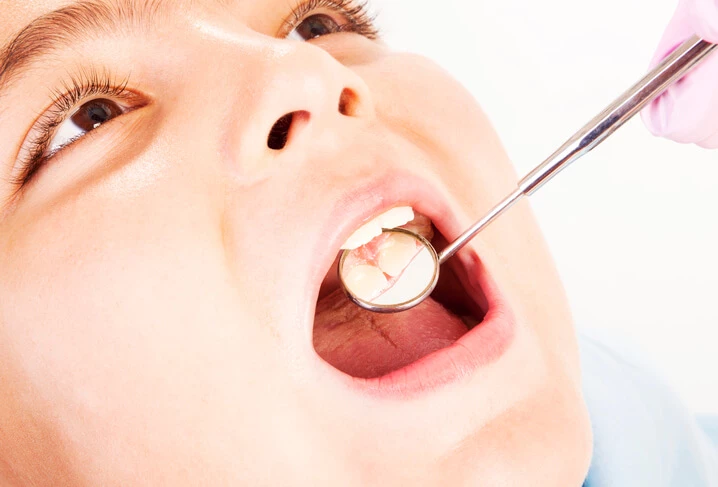Patients often ask if progenia is hereditary. There is no definite answer to this question. Jaw progression is considered as a congenital defect, but no mutation was found in a particular gene that would be responsible for the development of anterior occlusion.
What is progenia?
Progenia may seem like a trivial problem – however, it raises many complications. Incorrect spatial relations between the teeth of the maxilla and the jaw cause problems with biting off and chewing the food. Breathing is difficult – it is bothersome especially at night. It causes dry mouth and throat, increases the susceptibility to upper respiratory tract infections and periodontitis as well as caries. Other health consequences of progenia include:
- headaches,
- speech disorders,
- increase in tongue size,
- facial defects.
How to diagnose progenia?
The characteristic appearance of the patient's face often helps to recognise progenia. The elongation of the mandibular shaft extends the chin forward. The lower lip is usually placed in front of the upper lip, and (in advanced cases) it may be very tense. The labial-chin furrow is softened.
Dental examination shows incorrect positioning of lower teeth when compared to upper teeth. There may be accompanying periodontal changes or carious lesions. The dentist can also use functional tests. Patients affected by tooth progenia have a big problem with the mandible retraction test.
In order to carry out in-depth diagnostics and assess the stage of disorders, a dentist may use radiological tests (an X-ray or CT scan), impression models and/or facial photography. Classifications that assess the correctness of the occlusion, e.g. Angle's or cuspidal classification, are also helpful.

How to treat progenia?
Progenia is a complex health problem that requires the cooperation of specialists from various fields. The therapeutic team usually consists of:
- orthodontist,
- maxillofacial surgeon,
- prosthetist.
If progenia of the jaw is diagnosed at an early stage and the changes are not advanced, treatment can only be based on the intervention of an orthodontist. Therapeutic apparatuses help to restore proper anatomical relations between the jaw and mandible.
In cases of unsatisfactory results of orthodontic treatment or detection of changes in the advanced stage at the first contact with the patient (significant hypertrophy of the jaw or hypoplasia of the jaw), surgical intervention may be indispensable.
The surgery is usually preceded by orthodontist procedures – their aim is to ensure the best conditions for subsequent forming of occlusion. If the jaw turns out to be so narrow that it will not be able to contain the lower teeth, functional devices are designed to widen the upper row of teeth.
Depending on which bones had developed abnormally, the procedure involves manipulations on the lower jaw only or on both bones (mandible and maxilla).
Accompanying speech defects can be treated with exercises under the supervision of a speech therapist.
Progenia: does surgery make sense?
Many cases of malocclusion, including progenia in children, is due to physiological dysfunctions. Biting, sucking, breathing, and even body posture dysfunctions may result in incorrect mouth spacing. Prevention is always better than treatment – hence, it is important to pay attention to our child's behaviour.
Low-grade progenia can be successfully treated conservatively. However, if the therapeutic team decides otherwise, it is not recommended to postpone the surgery. Surgical methods are often the only way to completely cure tooth progenia, especially when the disorders increase and the orthodontist's efforts do not bring the expected results. Untreated progenia is associated with numerous complications, including faster caries development and periodontitis.
Progenia and speech impediments
Incorrect relations of anatomical structures in the mouth are reflected in speech defects. Tooth progenia is not an exception. People affected by anterior occlusion very frequently speak with a lisp. They also have difficulty with correct pronunciation of certain sounds (f, p, b, w). Moreover, improper tongue mobility and disturbed swallowing of saliva result in a characteristic gurgling when speaking.
In case of articulation defects, cooperation between the orthodontist and the speech therapist is important. Restoring the correct occlusion is an indispensable element in dealing with articulation problems. The sooner the malocclusion is diagnosed and treated, the better the subsequent results of corrective pronunciation exercises.
Summary
Progenia is a congenital bone defect involving excessive growth of the lower jaw in the anterior direction. It is associated both with a cosmetic defect as well as with other dental and laryngological problems. Progenia is diagnosed by a dentist on the basis of routine oral examination and additional tests.
The cooperation of many specialists plays an important role in its therapy. Low-grade progenia can be cured with the apparatus – however, more advanced disorders require surgical intervention. The treatment ensures good results, and the prognosis regarding restoration of the correct functions of occlusion and speech is good.



